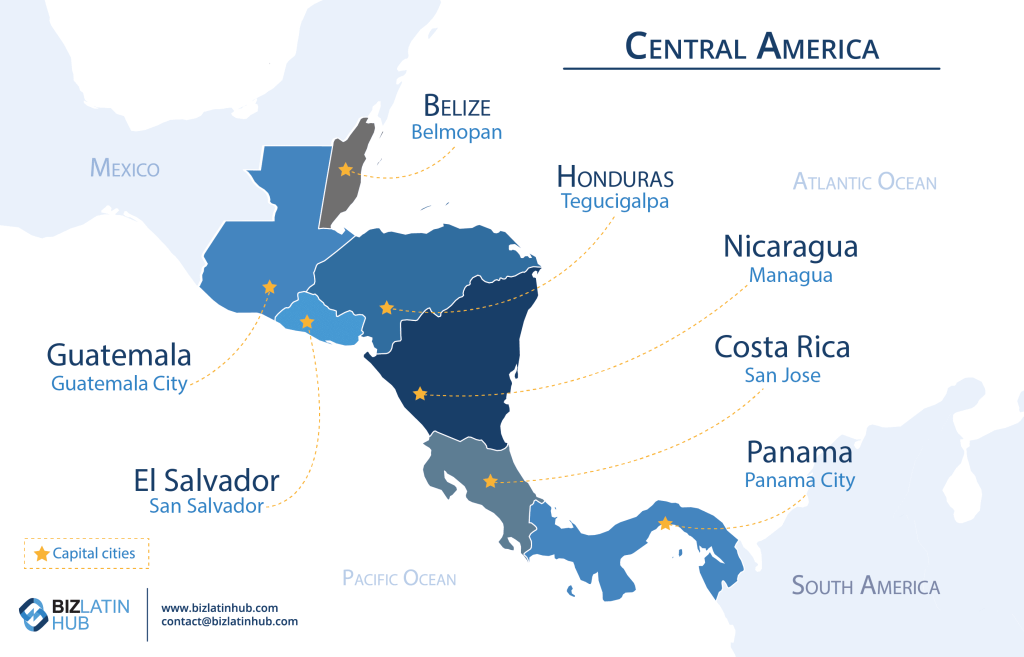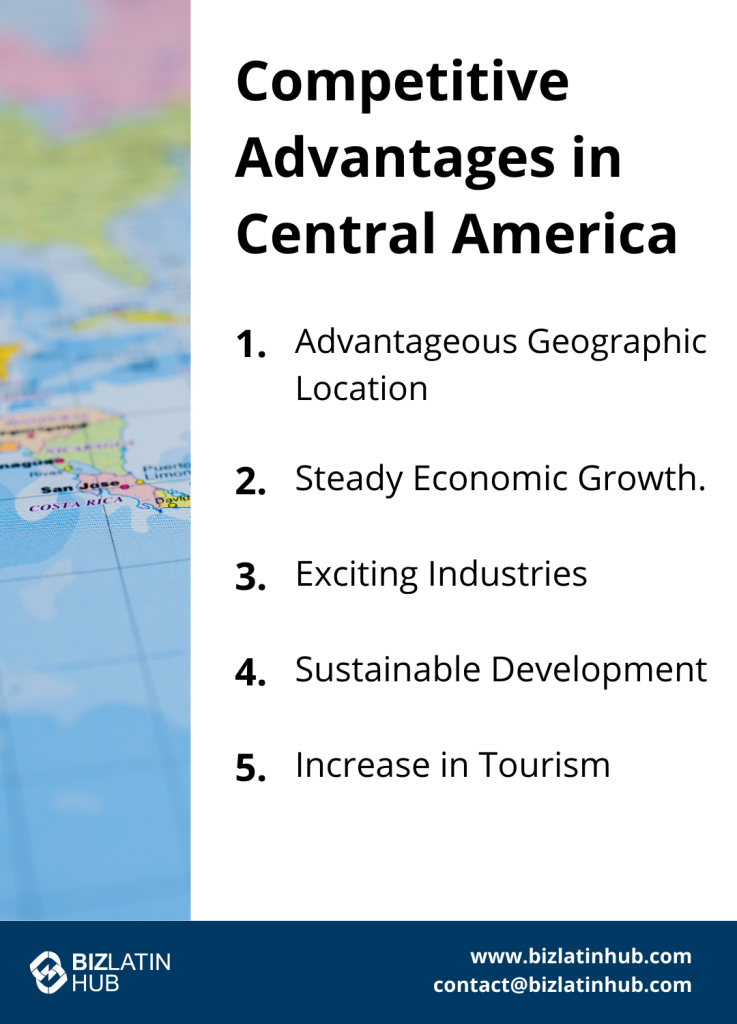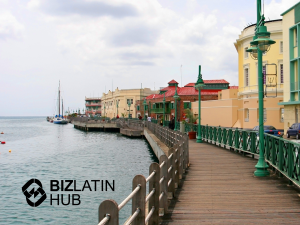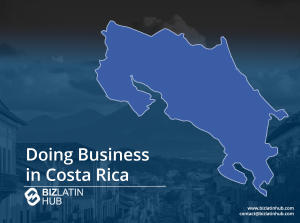The region is comprised of seven (7) countries; Belize, Costa Rica, Panama, Guatemala, El Salvador, Honduras, and Nicaragua with a total population closing in on 50,000,000. Although they share the Spanish language (minus Belize) and various borders, the countries vary greatly with respect to culture, history and the business environment. There are signs everywhere of business growth in Central America, though.
This informative piece is going to focus on business growth in Central America, while giving special attention to Costa Rica, and will examine a range of external and internal factors that affect investment and investor confidence in the region.
Biz Latin Hub can help you with market entry and company formation anywhere in the isthmus, as we are specialists in the region with 18 dedicated local offices across Latin America and the Caribbean. Wherever there is business growth in Central America, we are there to help foreign investors navigate local law and stay compliant and above board.
Central America Business Environment Overview
Traditionally, Central America has not been the first pick of investment locations for individuals and companies looking abroad to do business. While Latin America has always had its fair share of investment, with countries such as Chile and Peru excelling in the mining and METS industries, the various countries in Central America have often missed out on much-needed investment from abroad.
Unknown to most, Central America is well connected economically to the rest of the world, with a range of free-trade agreements, which provide a great platform to establish a trading company. Some FTA agreements in Central America include, but are not limited to:
- United States-Central America-Dominican Republic Free Trade Agreement (CAFTA-DR)
- Central America – European Free Trade Agreement (EU-CAAA)
- Central American Common Market (CACM)

These agreements provide an important platform to facilitate economic development for the economies that make up Central America. Due to great variations in productions between the countries in the region, they are able to leverage the strengths of one-another to grow their economies and foster important commercial and diplomatic relations.
In regards to the business environment, typically, northern Central America tends to see a heavy reliance on their textile and agricultural industries while unfortunately experiencing greater rates of poverty and advancing at a slower rate than southern Central America.
Sothern Central America, specifically Costa Rica and Panama, have quite advanced economies, with a shift in their economic models from the exportation of raw goods and textiles, to the development and exportation of high tech products as well as service sector business growth in Central America.
Central America Business and Investment Risks
While having a broad range of business opportunities available (which we will get into later), unfortunately, investment risks still impact investor confidence and operations in the region. Business investment risk varies throughout the region, however, there are three key business risks in Central America we have identified as being the greatest influencers on international investment.
Political and Economic Instability
While present across all regions, some countries in Central America experience higher levels of political and economic instability than others. The ‘Northern Triangle’ composed of Guatemala, El Salvador, and Honduras are rebuilding after civil wars in the 80s that left violent legacies and fragile national institutions. With peace now established, they are firmly looking to the future.
Corruption and violence strongly impact investor confidence in the region and despite developments, many investors are still hesitant to consider these zones as a viable place to do business. The region has some of the most promising signs of business growth in Central America, though, for those ready to accept risk.
If the political systems and institutions can respond to the needs of the people and society, significant advancements can be made.
Education challenges
The region needs to adopt a long-term approach to the future development and success of their respective regions, with well thought out investment in the education sector strongly needed. Business growth in Central America relies on a steady stream of competent and well qualified young workers.
Education has and will prove to be an essential factor in the growth of Central America. Costa Rica is a great example of a country that has invested heavily in the strengthening of its education system. This has played a huge role the development of the country, at a pace that far outweighs Central America and further abroad.
Opportunities and Competitive Advantages in Central America
Central America boasts a wealth of business opportunities for foreigners, and a range of competitive advantages in various sectors.

Geographical Location
The geographical location of Central America brings with it both advantages and disadvantages. Central America forms the bridge that connects the well developed consumer markets of North America with the rapidly developing and growing South America.
Not only that, but the region has excellent access to ports on both the Pacific and Atlantic oceans, making it a crossroads for intercontinental trade routes. Nowhere is this more obvious than the mighty Panama canal, which allows shipping from China to reach the lucrative markets of Europe.
Steady Economic Growth
The entire region has seen almost unbroken growth rates throughout the century to date, with Costa Rica and Panama leading the charge. However, even the northern countries have developed rapidly, just from a much lower initial base.
With demographics still in their favor for decades to come, there remain a plethora of opportunities for business growth in Central America, with a number of sectors ripfor development, often through tech. Fintech, for example, is just starting to take off in the isthmus and has enormous potential.
Exciting Industries and Sectors in Central America
Latin America as a whole has seen the strengthening of traditionally dominant sectors such as the Mexican automotive industry, to new sectors such as non-conventional renewable energy in Chile and E-commerce in Argentina. While South America has typically developed at a faster rate than Central America, the region as a whole boasts a number of exciting industries and sectors.
From the traditionally strong markets of textiles and agriculture in the north of Central America to the service based technological sectors in Costa Rica and Panama, the region is seeing the growth of business opportunities for both locals and foreigners. Costa Rica, the innovation hub for technology, is experiencing a huge boom in the service industry.
The country´s highly educated and very bilingual English and Spanish population, along with the welcoming business environment has turned the country into an attractive destination for foreign technology companies. Another exciting and developing country is Nicaragua who also has a young and educated workforce.
Many foreign companies have found that doing business in Nicaragua strengths their global competitive advantage by reducing human capital costs while maintaining high-quality control.

Sustainable Development Sector in Central America
Central America has great potential for foreign investment in the sustainable development sector, with a host of projects in the renewable energy sector – notably wind, solar and hydroelectrical. Despite the region not being renowned for its efficiencies in renewable energy, the region has many competitive advantages, one being its share in non-hydro renewable energy is impressive (13%) when compared to the global average (5%).
“Costa Rica’s commitment to sustainability is not an accident. The country has been without an army since 1949 and this has had an obvious impact on its human development indicators. Sustainable development – with three key pillars in action: economy, society and environment, is part of the soul of a country that allows it to enjoy freedom and peace.” – Mr Jairo Hernandez, Costa Rican Ambassador to Australia.
The Rise in Tourism in Central America
As the world embraces travel like never before, many people are looking to new destinations. Central America has exploded on the tourism map in the past decade and this trend is only expected to continue. A great climate, plenty of coastlines, economic prices and friendly locals have meant that the tourism industry is booming.
This industry growth creates the opening for much-needed investment in the sector (often coming from abroad). In Costa Rica, tourism has surpassed agriculture as the largest industry in the country, with eco-friendly and sustainable lodges located in the beautiful forests and parks. Additionally, in the last two years, new air carriers have opened nonstop services to Costa Rica from a number of cities.
What does the Future Hold for Central America?
Mr. Jairo Hernandez looks forward to a promising future for Central America. He is by all means aware that the region is not without its issues, however, the overall view of the region is promising. Mr. Hernandez sees five vital areas that will create opportunities to move the country forward.
- Increase importance placed on the educational sector
- Transformation of political systems
- Further opening up of economies to foreign participation and broadening economic ties
- Adopting a forward-thinking mentality (looking 10-20 years ahead as opposed to the next election)
- Creation of conditions to encourage sustainable development
As the region develops, opportunities for investment grows, positively contributing to the local economies and ultimately the lives of the inhabitants. The region as a whole has seen the benefits that foreign investment brings. Central America, similar to Latin America as a whole, has an exciting future ahead, and through the development and implementation of policies as mentioned above by Mr. Hernandez, the countries that encompass the region have the opportunity to prosper and develop.
“Central America remains a very privileged geographical area bridging the northern and the southern portions of the Americas. Practically without exception, the countries are committed to the attraction of foreign investment in various forms, with the region already seeing the benefits that this investment brings them. Being a region composed of small countries has many advantages; there is great potential for growth and investment in diverse projects including public infrastructure, manufacturing ventures, tourism and service industries. Privileged by nature, this part of the world is a potential laboratory for sustainable development practices that make sense from a business perspective” – Mr. Jairo Hernandez.
Biz Latin Hub can help you with business growth in Central America
We welcome the opportunity to provide you our professional company formation and back office services in Central America.
At Biz Latin Hub, we are a market leader for supporting businesses from over the world start their business in Central America.
Our team of qualified, multilingual professionals in Central America provides a suite of customizable market entry and back office services to support your expansion. Contact us now for more information, and become part of the Central American business scene.
Learn more about our team and expert authors.






